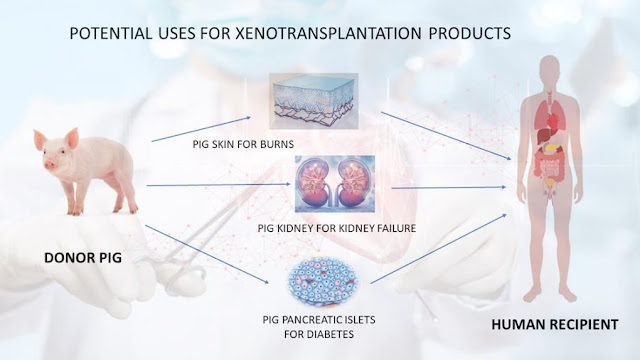Xenotransplantation
Do you know that there are thousands of people who owe their lives to pieces of nonhuman cells?
 |
Image Source - Google | Image by - U.S. FOOD & DRUG |
For the past years,
people have been replacing damaged human organs with nonhuman cells. This
process is known as transplantation. Put in other words, it would go as the transplantation
of organs from one species to another.
Sounds weird right?
Xenotransplantation
draws so much interest because of the serious shortage of human organs the
healthcare industry has been subjected to. In 2019, a recent study from the
Association France Transplant through the Agency of Biomedicine reports that
500 to 800 patients die each year for lack of a transplant.
Transplantation from
human to human is not always an easy task. Most of the time the difficulty lies in the mismatching aspect
of blood types or more, the new organ is often rejected by the recipient
because of what is known here as human leukocyte antigen.
You might be wondering
why?
Well, almost every
person is unique. This uniqueness makes each person to have a different kinds
of what is known here as human leukocyte antigen. So when you undergo a transplantation
process and the donor’s human leukocyte antigen looks new or foreign to your
immune system, it will definitely attack the transplanted tissues. This can
probably lead to many other complications that we prefer not to list here. This
mismatching problem puts so many people on the waiting list for years.
But,
There are a few ways
around this problem and one of them is to try to approach this problem from a
complete different angle; skip human and move to animals, mainly pigs. This is
not exactly something to be excited about but the truth is that human beings have so
much in common with pigs.
Well, this might be a
bitter pill to swallow but it is what it is. Most humans have an immune system
that somehow functions in a similar way to pigs and your organs happen to be
doing the same things.
Thanks to this
process, the idea or concept of the perfect match between animal cells and human cells
has been established. Therefore, animals happen to win the role of first choice
donors since they are all available, unlike humans.
But a question stands
still, how did that start?
The very first attempt to xenotransplantation date back to 1667 when Sean Baptist, a French doctor performed lamb blood transfusion on a boy. In the Second World War, a scientist named Medawar made many experiences that were all punished by failure. In 1963, Reemtsma carried out 13 xenotransplantation.
He did transplanted
chimpanzee kidneys into terminally ill patients. Sadly those process were all punished
by failure except one case which was putting into picture a lady who died nine-month after receiving the kidney. A careful autopsy shows that the kidney was
normal and has not been rejected.
Objectives of xenotransplantation
Xenotransplanttioan aims at saving the lives of patients. This procedure is always performed in a dramatic context. The ultimate goal of xenotransplantation is to allow the transplantation of animal organs or cells with immediate function in the recipient. This approach would immediately eliminate the shortage of human organs available for transplantation, which currently results in a significant rate of mortality of patients on the transplant waiting list.
Immunological differences between pigs and humans lead to immediate rejection of pig tissues by humans, but this rejection has been partially controlled by the genetic modification of pigs. Because of the risk of infection by pathogens passing from animals to humans, the World Health Organization recommends that clinical application should only take place when appropriate regulations are being set or applied.
Risks of xenotransplantation
From the 1960s to the
1980s, several attempts at xenotransplantation were made. They all ended in the
death of the patients. At first, surgeons tried to keep this secret and
sometimes hid certain information about these operations.
It is important to recall
that pigs are the ideal donor for human xenotransplantation at this time. However, this process comes with its own set of risks. Immunological rejection of the
animal tissue, molecular incompatibility, metabolic differences between the
donor organ and humans, the risks of transmission of infectious diseases just
to name them are the complications that can occur.
Benefits
Cellular
xenotransplants can be used to treat people with diabetes, Alzheimer's disease, or Parkinson's. Tissue xenotransplantation can be used for skin grafts for burn
victims, corneal grafts for the visually impaired, or bone grafts for limb
reconstruction.
Final thought
It is important to understand that xenotransplantation has been a solution to ease the pain of patients. The many improvements made in the field of xenotransplantation and the clinical trials are signs of hope for all those people suffering.
